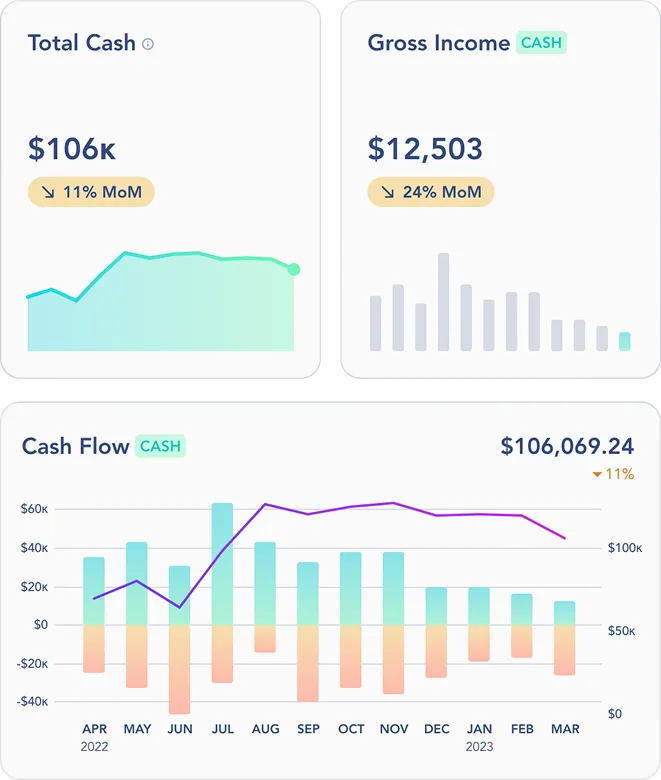
How to Build the Perfect Startup Financial Tech Stack (According to a Founder Who Has Done It)
 Bebe Kim
Bebe Kim
At the heart of startup success is financial management. It's not just about profits or how much you raise; it's also about how well you manage your money day-to-day.
Unfortunately, as many first-time (or even second- or third-time) founders learn, managing your startup's finances is no walk in the park. Even small teams with lean budgets grow out of DIY spreadsheets in about the two hours it takes to make them, and the repercussions of not setting your team up for financial success early can lead to catastrophic issues down the line.
Luckily, you don't have to learn the hard way how to manage your startup's finances. As someone who has founded their own company, I've learned what it takes to build the perfect financial tech stack — one that can help you grow your venture with confidence.
Why getting your startup's financial tech stack right matters
The main benefits of a modern, optimized financial tech stack boil down to two main positives: more time and lower costs.
When you use outdated, inefficient accounting systems or apps, you and your team will need to make up for those shortcomings. That means hours of reconciling numbers, manually entering data, and double-checking your finances so you don't run afoul of the IRS or look silly in front of investors.
Even seemingly simple decisions can negatively affect your business if you're unlucky. For example, let's say you run your business' operating account out of the bank you've used your entire life. You know them, have worked with them, and maybe it'll save you some time not needing to go to two locations for personal and business banking needs. Understandable.
Unfortunately, your bank's technology — like most American banks — may not play well with the rest of your financial tech stack. So now, when you categorize your expenses, all you get is an incomprehensible string of numbers and letters.
You and your team now need to figure out what expense this was and how it should be categorized, and that can take a lot of time.
What is less obvious is that these inefficiencies are costing you a lot of money as well.
When your bank can't give you accurate and descriptive transaction records, someone has to untangle that. In most cases, that'll be your accountant who will have you spending hundreds a month in accounting fees just because of this one choice.
Now your financial numbers are late, they're more likely to have inaccuracies, and they're costing you far more than you ever thought they could, all because you opened a bank account at the wrong bank.
This is just your bank account. When you start a company, you make tons of financial decisions that can either help you succeed or hold you back.
What are the long-term benefits of a scalable financial tech stack?
In the short term, a better financial tech stack will save you money and time. The benefits add up even further in the long term. Here are the most important ones:
- Improved efficiency and accuracy: Automate repetitive tasks to eliminate human error and keep your books clean from day one.
- Real-time financial insights: Access up-to-the-minute financial data to make informed decisions faster.
- Smoother investor relations: Provide investors with accurate, real-time reports that boost their confidence in your business.
- Built-in scalability: The right tech stack grows with your company, so you won't have to switch systems as you scale.
- Faster financial close: Automate your month-end processes to close your books quickly and keep your financials up-to-date.
7 steps to building your financial tech stack
Step 1: Set up your bank accounts
TLDR
- Open two bank accounts (one for operations and one for treasury) at different institutions that both follow open banking standards.
Before everything else, set up your bank accounts and get ready to go so that when you get funding, that money can be transferred to a place other than your private account.
Most startups will need two accounts:
- Operating account: For day-to-day expenses.
- Treasury account: For investing your extra funding.
If you raise less than $3 million, you can forgo the Treasury account for now, but once you pass that threshold, it's crucial to open a second account at a separate bank.
When choosing the banks you'll work with, look for ones that follow open banking principles. These banks can securely and seamlessly share your financial information (with your permission) so that you can integrate your financial data with the rest of your tech stack — no incomprehensible strings involved. It's also important to prioritize banks offering robust APIs for automation, saving you the hassle of manually pulling transaction data monthly.
In the EU, open banking laws are already in place, so open banking is the norm. But, despite some promising signs, there is not yet any law forcing banks in the US to provide open access to their data.
However, there are options. For US-based founders, look for more forward-thinking, startup-friendly options like Mercury or Arc for your banking needs.
Another tip is to always open your Operating and Treasury accounts at different banks. Even if your funds are insured and backed by the government, splitting your accounts between two different financial institutions ultimately spreads your risks should another bank collapse happen.
Step 2: Hire an accountant
TLDR
- Hire a professional accountant as soon as you raise money so they can set up your financial foundation and ensure you meet all compliance requirements from the start.
As soon as you raise any capital, you must stop what you're doing and hire an experienced accountant familiar with the startup world.
Many first-time founders think they can handle accounting on their own while their company is small.
Usually, they're wrong.
Accounting for startups is not intuitive. It is extremely complex, and it is extremely important you get it right the first time. Mistakes made early on can snowball into larger issues later, costing you time and money to fix.
Here are just a couple of ways early investments in better accounting will pay dividends down the road:
- Corporate structuring: An experienced accountant will help you choose the right corporate structure (LLC, C-corp, S-corp) from the start, ensuring you avoid unnecessary taxes down the line.
- Tax efficiency: An accountant can help ensure you maximize any deductions or credits available to startups, like R&D tax credits.
- Proper accounting system setup: Your accountant will set up your financial tech stack to accurately categorize all your income and expenses, making tax time and financial reporting a breeze.
- Investor-ready financials: Your accountant will ensure you have clean, audit-ready financial statements that make it easier to raise additional funding.
- Compliance with state and federal regulations: Your accountant will ensure you meet all your regulatory obligations, such as payroll taxes and state business filings.
- Financial strategy and forecasting: A good accountant will help you understand your runway, anticipate future funding needs, and ensure you're financially prepared for growth.
So do your future self a favor and invest in an accountant early before your venture heads in the wrong direction.
Step 3: Apply for a business credit card
TLDR
- Choose a modern business credit card that scales with your company, integrates with your accounting software, and isn't tied to your personal credit.
After setting up your bank accounts, the next step is to apply for a business credit card that supports your startup's growth and keeps your personal finances separate from your business operations.
While it might seem tempting to use your personal Amex for business expenses (who doesn't love free points?), tying your business finances to your personal credit can lead to issues down the line.
Here are just a couple of reasons that prove the points just aren't worth it:
- Tied to personal credit: Business purchases affect your personal credit score, which can be risky if your business goes through financial ups and downs.
- Limited scalability: As your team grows, you can't easily delegate spending authority with personal cards, making it harder to track and control purchases.
- Expense tracking becomes messy: Mixing personal and business expenses complicates bookkeeping and increases the chances of errors in your financial records.
- Lack of integration: Personal credit cards typically don't offer APIs or integration with your financial tech stack, meaning accounting requires manual entry and reconciliation.
- Audit risk: Using personal cards for business could complicate things if your company is ever audited, as you'd need to provide a detailed separation of personal vs. business expenses.
Instead, pick a business credit card provider designed specifically for startups.
Solutions like Ramp or Brex aren't tied to your personal credit history and can grow with your business. They allow you to issue cards to team members and set spending limits as needed.
Another thing to look for is a credit card that integrates directly with your financial tech stack. Choose cards with robust APIs that allow you to sync transaction data seamlessly with your accounting software, removing the need for manual expense tracking and reducing the likelihood of errors.
Step 4: Get your payment system up and running
TLDR
- Set up a payment processing system like Stripe or PayPal to handle customer payments and ensure it integrates smoothly with your accounting software.
Once your bank accounts and business credit cards are set, the next step is to establish a payment system that allows your business to accept and manage customer payments seamlessly.
The right payment processor handles transactions efficiently and integrates with your financial tech stack to automate and simplify your bookkeeping.
Here's what to look for when shopping around:
- Seamless integration: The best payment processors integrate directly with your accounting software, eliminating manual data entry and making everything easier and less prone to errors.
- Invoicing automation: Automated invoicing for customers makes it easy to track who has paid and who hasn't.
- Multiple payment options: Choose an option that offers your customers multiple payment options, including credit cards, ACH transfers, and digital wallets, making it easier for them to pay you.
- Global reach: If you plan to scale internationally, choose a payment processor that makes it easy to accept payments from customers all over the world.
Most startups will benefit from modern, flexible payment processors like Stripe or PayPal. Both offer tech-friendly APIs and smart features that will help you service your customers while saving countless hours of manual reconciliation, keeping your cash flow clear and up to date.
Step 5: Choose your payroll provider
TLDR
- Select a modern payroll provider like Gusto or Rippling. These providers automate payroll, handle tax filings, and integrate with your accounting software to keep everything synced.
Many founders forget that payroll is much more than just paying employees a set amount every month.
You need to know what money is going where, whether it's salaries or health insurance.
Trying to do this all manually is a recipe for disaster, which is why going with a modern payroll system makes so much sense, even for very young startups.
A payroll provider like Gusto or Rippling can automatically make sure you pay employees on time and you are compliant with payroll taxes and other regulatory requirements. This is even more of a blessing when you have employees in different states, as the software will automatically take care of all of the different state taxes and regulations for you.
Here are some other reasons that investing in a modern payroll provider makes sense:
- Automated payroll and tax filings: These tools automatically handle the complex calculations involved in payroll, including withholdings, benefits deductions, and tax filings at both the state and federal levels.
- Direct integration with your accounting software: Modern payroll systems integrate seamlessly with tools like Digits, ensuring payroll expenses are automatically categorized and reconciled without manual entry.
- Employee self-service: Employee portals allow your staff to access pay stubs, manage direct deposit settings, and update personal information without needing to go through HR or finance.
- Compliance with local, state, and federal laws: Payroll regulations vary greatly depending on your location, and non-compliance can lead to costly penalties. A modern payroll provider helps you avoid all of those issues.
Step 6: Automate bill pay
TLDR
- Use a modern bill pay solution like Digit's AI Bill Pay to automate vendor payments, reduce manual work, and keep your books up to date in real time.
As your startup grows, manually paying vendors and contractors can quickly become time-consuming and prone to errors. Automating bill pay is not just nice to have, but it also makes certain that payments are on time and your records are rock solid.
Here's why automating bill pay is a smart move for startups:
- Integrated with your accounting software: Digits Bill Pay syncs payments directly to your accounting system, automatically updating your books with each transaction in real time.
- Vendor management made easy: Automated systems allow you to set up recurring payments and track vendor invoices, so you never miss a due date or lose track of what's been paid.
- Enhanced control and security: You can establish approval workflows to ensure payments are properly authorized, creating a built-in audit trail that provides transparency and helps avoid fraud.
Another benefit of a tool like Digits is that it helps future-proof your financial processes. While an ad-hoc approach might work in the early days, as your vendor list grows, a system like Bill Pay ensures everything runs smoothly, with timely payments and a clear, organized audit trail.
With automation, you can scale your payment processes confidently, knowing your financials are always accurate and up-to-date.
Step 7: Create your cap table
TLDR
- Use cap table management tools to organize ownership, track equity grants, and ensure your company's financials are transparent and investor-ready.
A well-organized cap table is essential for any startup. it tracks the ownership stakes in your company, including founders, employees, and investors.
It's not just a document — it's a dynamic tool that gives you clear visibility into your company's equity structure and helps you make informed decisions as you raise funds and grow your team.
Here's why building a proper cap table early on is critical:
- Centralized ownership tracking: Tools like Carta or Pulley allow you to manage equity ownership in one place, from founder shares to employee stock options. This makes it easier to track and allocate shares as your company grows.
- Investor transparency: A clear cap table gives potential investors a transparent view of your company's ownership structure, which is crucial during fundraising rounds.
- Employee equity management: Managing employee stock options manually can become complicated as your team expands. A cap table tool automates this process, ensuring employees receive and understand their equity grants clearly.
- Real-time updates and compliance: With modern tools, your cap table stays up-to-date as you issue new shares or options and ensures you comply with regulatory requirements for equity management.
A cap table isn't something you can afford to manage manually, especially as your company scales. Using a dedicated tool from the start will ensure your ownership structure is organized and ready for future funding rounds.
Timeless advice to keep in mind
Things change quickly, and today's best software, bank, or app may not be the best tomorrow. With that in mind, here are some timeless criteria to consider when deciding which financial solution is best for you:
Use tools built for startups
Always choose solutions designed specifically for startups, not one-size-fits-all options.
Startups move fast and need flexible, scalable tools that can grow alongside them. Unfortunately, many traditional tools just don't cut it for modern startups. You need tools built for speed and adaptability.
If the tool you're looking at isn't built with startups in mind, you might be looking at the wrong tool.
Prioritize tools with strong APIs and built-in automation
APIs and automation aren't just buzzwords — they save you time and reduce human error.
When your systems are connected through APIs, your financial data flows seamlessly between tools, keeping everything updated automatically. This means fewer manual inputs and more accurate financials.
Get accounting advice early
Don't wait until you're dealing with complex financials to bring in an accounting professional.
Get accounting advice early to ensure your systems are set up right from the start. It'll save you from costly mistakes down the road and ensure you're always compliant with tax laws and regulatory requirements.
Modern accounting for modern startups
Building the right financial tech stack is key to growing your startup efficiently.
One way to ensure you get the best possible solution is to use Digits for your bookkeeping and accounting needs. Digits automates your financial processes, giving you real-time data on burn rates and runway, automatically categorizing expenses, and allowing you to close your books in days, not weeks.
With seamless API integration, all your financial tools work together to provide accurate, up-to-date information with minimal effort on your part.
Ready to get your financial tech stack started right or need help putting it in order?
Book a demo to learn how Digits can help you harness the power of AI and machine learning to optimize your finances.


